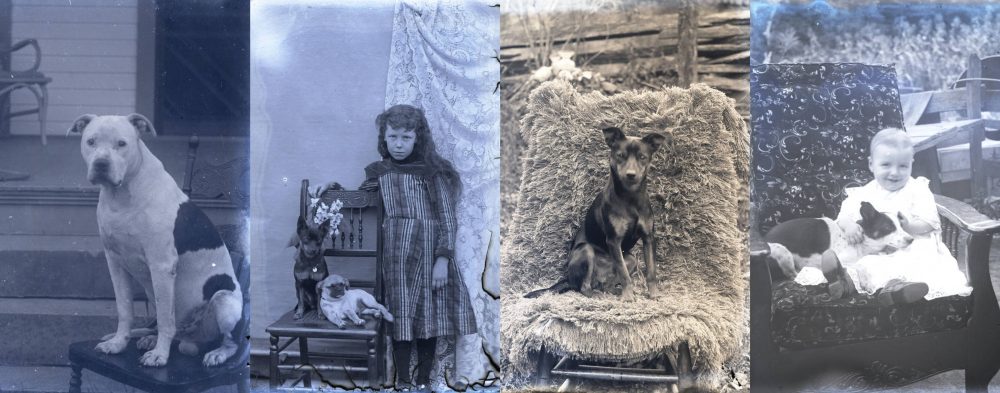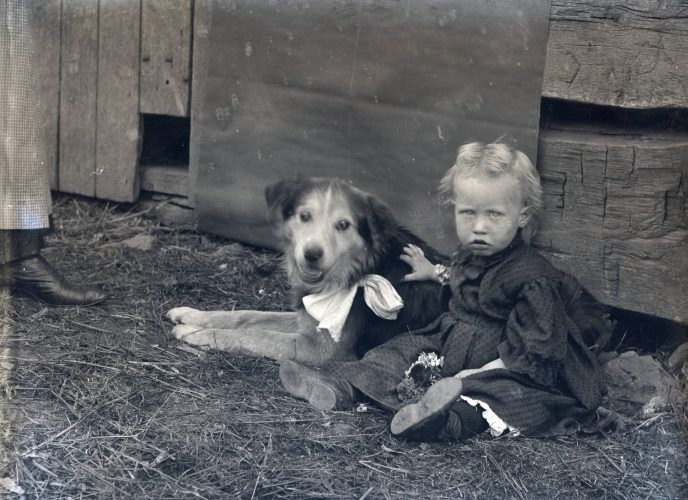It’s a Dog’s Life: Dogs on Ohio Memory

Although there is accepted fossil evidence of domestic dogs dating back 14,000 years, scientists disagree about when domestication happened (some put the date much earlier), and whether humans or the dogs themselves drove the process (known as self-domestication, or “survival of the friendliest”). Regardless of when or how the canine/human partnership began, dogs have become an important part of human society by providing protection, assistance, and companionship. Images of dogs appear in artwork from cave paintings to Renaissance portraits to modern art. But it was the invention of photography in the mid-1800s that began to make canine portraiture more accessible. Before #dogsofinstagram, people spent a century and a half taking photos of their dogs.

The first commercially practical photographic process was the daguerreotype, which produced an image on a silvered copper plate and was introduced in 1839. Some of the earliest surviving photos of dogs are daguerreotypes taken in the 1850s. Although photographic processes and equipment evolved rapidly, for most of the 1800s photography equipment was large and expensive; photographs were therefore also pricey and were often taken in studios. At a time when having a portrait taken involved effort and expense, the fact that people included their dogs shows the importance they placed on their furry companions.
Toward the end of the 1800s, pets (and pet portraits) became more common in middle-class households. As cameras got smaller and less expensive, photography moved out of the studio and into the world at large. Itinerant photographers like Albert J. Ewing traveled from town to town, taking portraits and photos of everyday life. Many of the dog photos on Ohio Memory come from the Ewing collection, including this photo of a dog sitting on a chair with a (partially) hidden person holding it still. (For more examples of hidden humans in photography, see our blog post about hidden mothers.)

However, a dog’s life wasn’t all fun and games. The images at left show working dogs in roles from mascot to entertainer to hunting partner. Spad, the dog at the top left, was the mascot of the 94th Aero Squadron in World War I and was named after the French biplanes flown by the pilots. The squadron, commanded by Ohioan Eddie Rickenbacker, was one of the first American fighter squadrons to reach the Western Front, and was credited with the first and last official victories of the American Air Service. The remaining images show the mascot of Toledo’s Fire Station #7 perched on a horse-drawn fire truck ca. 1900; trained dogs (along with ponies and macaques) that performed in Casper’s Pony and Dog Show during the 1930s and 1940s; and a hunting dog from the Albert J. Ewing collection.
Ohio is home to at least two celebrity dogs. Laddie Boy was born in Toledo and gifted to President Warren G. Harding the day after his inauguration. Although there had been numerous White House pets before him, Laddie Boy was the first to receive regular press coverage; headlines included “Laddie Boy a Newsboy” (he brought Harding the newspaper every morning at breakfast) and “Trees White House Cat.” The president and the first lady were both photographed with Laddie Boy. Another Ohio Airedale, James Thurber’s dog Muggs, was made famous in Thurber’s short story “The Dog Who Bit People.”
Whether famous or not, dogs have been part of our lives and our families for thousands of years. And, as our last image shows, they don’t mind dressing up for a family photo.

Thank you to Stephanie Michaels, Research and Catalog Services Librarian at theState Library of Ohio, for this week’s post!



Leave a Reply
You must be logged in to post a comment.